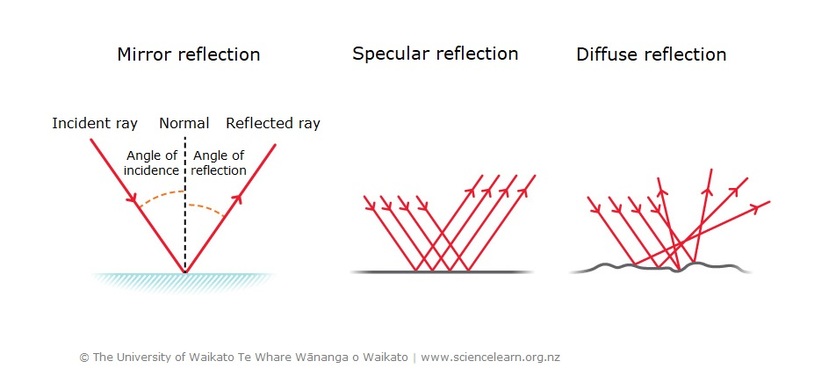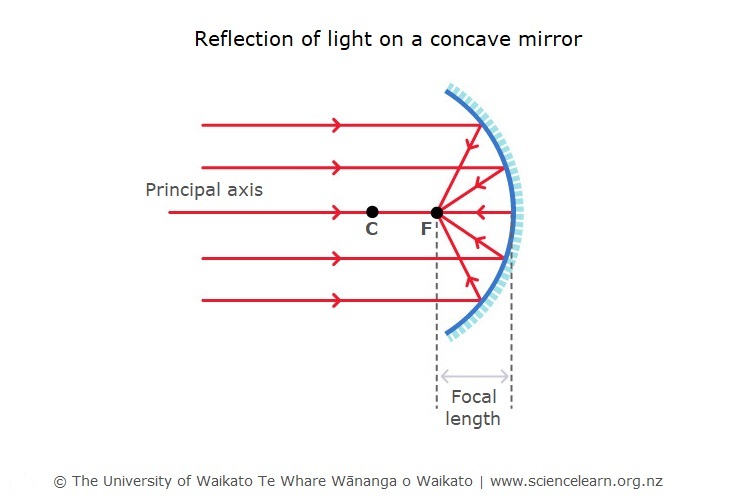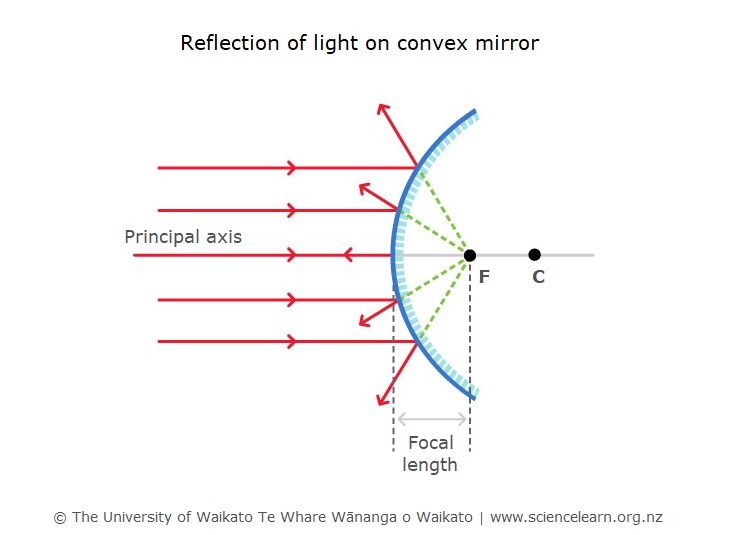Reflection is when light bounces off an object. If the surface is smooth and shiny, like glass, water or polished metal, the light will reflect at the same angle as it hit the surface. This is called specular reflection.
Diffuse reflection is when light hits an object and reflects in lots of different directions. This happens when the surface is rough. Most of the things we see are because light from a source has reflected off it.
For example, if you look at a bird, light has reflected off that bird and travelled in nearly all directions. If some of that light enters your eyes, it hits the retina at the back of your eyes. An electrical signal is passed to your brain, and your brain interprets the signals as an image.
Specular reflection
The angle at which light hits a reflecting surface is called the angle of incidence, and the angle at which light bounces off a reflecting surface is called the angle of reflection
If you want to measure these angles, imagine a perfectly straight line at a right angle to the reflective surface (this imaginary line is called ‘normal’). If you measure the angle of incidence and the angle of reflection against the normal, the angle of incidence is exactly the same as the angle of reflection. With a flat mirror, it is easy to show that the angle of reflection is the same as the angle of incidence.
Water is also a reflective surface. When the water in a lake or sea is very still, the reflection of the landscape is perfect, because the reflecting surface is very flat. However, if there are ripples or waves in the water, the reflection becomes distorted. This is because the reflecting surface is no longer flat and may have humps and troughs caused by the wind.
It is possible to make mirrors that behave like humps or troughs, and because of the different way they reflect light, they can be very useful.
Concave mirrors
The inside curve of a spoon is an example of a concave mirror
Concave mirrors are used in certain types of astronomical telescopes called reflecting telescopes. The mirrors condense lots of light from faint sources in space onto a much smaller viewing area and allow the viewer to see far away objects and events in space that would be invisible to the naked eye.
Light rays travel towards the mirror in a straight line and are reflected inwards to meet at a point called the focal point.
Concave mirrors are useful for make-up mirrors because they can make things seem larger. This concave shape is also useful for car headlights and satellite dishes.
Convex mirrors
Convex mirrors curve outwards, like the outside of a balloon.
Parallel rays of light strike the mirror and are reflected outwards. If imaginary lines are traced back, they appear to come from a focal point behind the mirror.
Convex mirrors are useful for shop security and rear-view mirrors on vehicles because they give a wider field of vision.
Scattering of light
Some light is scattered in all directions when it hits very small particles such as gas molecules or much larger particles such as dust or droplets of water.
The amount of scattering depends on how big the particle is compared to the wavelength of light that is hitting it. Smaller wavelengths are scattered more.
“Why is the sky blue?” is a common question. Light from the sun is made of all the colours of the rainbow. As this light hits the particles of nitrogen and oxygen in our atmosphere, it is scattered in all directions. Blue light has a smaller wavelength than red light, so it is scattered much more than red light. When we look at the sky, we see all the places that the blue light has been scattered from.
This is similar to the question: “Why are sunsets red?” When the Sun appears lower in the sky, the light that reaches us has already travelled through a lot more of the atmosphere. This means that a lot of the blue light has been scattered out well before the light arrives at us, so the sky appears redder.
Clouds appear white because the water droplets are much larger than the wavelengths of light. For this situation, all wavelengths of light are equally scattered in all directions.
Activity ideas
In Light and sight: true or false? students participate in an interactive or paper-based ‘true or false’ activity that highlights common alternative conceptions about light and sight.
In Investigating reflection students investigate specular and diffuse reflection by looking into a dark box and shining a torch at various objects, coloured paper and a mirror.
To model blue sky and a red sunset, try shining white light from a torch or a projector into a glass container of water with a few drops of milk in it. You should see a blue haze from the sides. If you look to the far end of the container, you should notice the light has a reddish hue.




